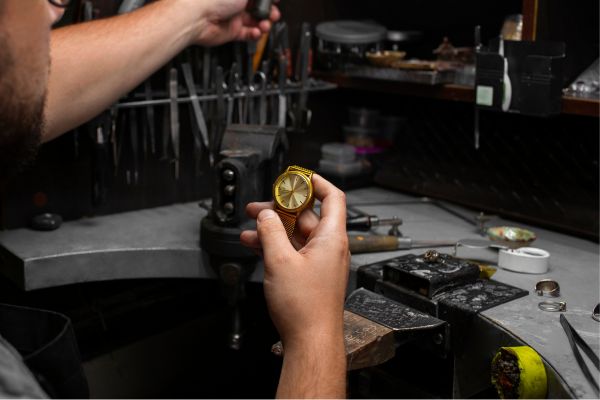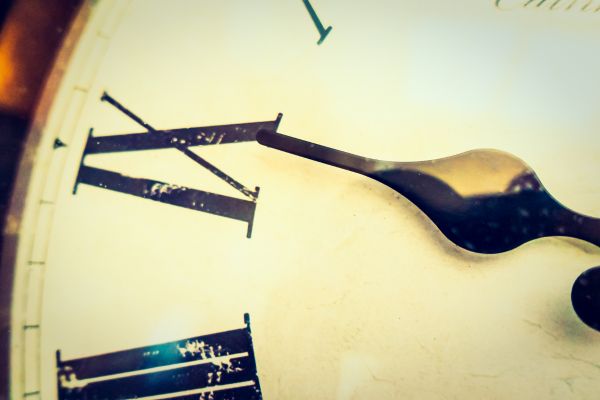Summary :
- Origin and concept of the death zone
- Better understanding the death zone for automatic watches
- What challenges for watchmakers?
- Effects on accuracy and durability
- Tips to avoid the death zone
The death zone is a phenomenon that refers to a period when it is risky to adjust an automatic watch, as it can affect its accuracy and cause damage. This sensitive period is particularly relevant for automatic watches, which rely on many internal moving mechanisms.
Origin and concept of the death zone
The “death zone” refers to a delicate time to set an automatic watch, which is typically between 9 p.m. and 3 a.m. During this time, the date-changing mechanism is active, meaning internal parts, such as calendar wheels and levers, are moving or under tension in preparation for the date change. This date-changing process begins well before midnight, even though the visible change occurs around midnight. Setting the watch at this time can disrupt these sensitive components, causing damage to the mechanism or complications to become desynchronized, sometimes requiring costly repairs.
Automatic watches are particularly vulnerable during this death zone, as their date-changing mechanism is active. Adjusting the watch during this period can damage the internal components.
Better understanding the death zone for automatic watches
Automatic watches operate using a rotor that rotates with the movements of the wrist. This rotor stores energy and transmits it to the mainspring, which powers the watch mechanism. Unlike quartz watches, which use a battery, automatic watches rely on the wearer's natural movements to function.
The dead zone is a period when the date change mechanism is active. This means that some internal parts, such as the calendar wheels and levers, are moving or under tension in preparation for the date change. These components are delicate and in full activity during this phase. Adjusting the watch during this period risks disturbing these parts, which can lead to problems such as loss of accuracy, stopping the watch, or even irreversible mechanical damage. This is why it is important to avoid adjusting an automatic watch during this specific period.
What challenges for watchmakers?

For watchmakers, avoiding the death zone is a challenge, as a wrong adjustment during this period can have serious consequences for the watch, even for high-end models like the Santos de Cartier or the Speedmaster from Omega . Most watch movements equipped with a date function have a death zone, where setting the date is risky. For example, some brands have had to deal with watch recalls due to incorrect adjustments made during this sensitive period, causing malfunctions. There are, however, a few exceptions, such as the Calibre Royal from Pequignet, which was designed without a death zone, but these cases are rare.
Effects on accuracy and durability
When the watch enters the death zone, its accuracy deteriorates significantly. Improper adjustment can not only impair daily accuracy (gains or losses of seconds per day), but also reduce the power reserve , rendering the watch unable to operate autonomously. In addition, incorrect adjustment can accelerate the wear of movement components , reducing the overall life of the watch.
Tips to avoid the death zone

To avoid the death zone, it is imperative that you do not set the date when the hands are positioned between 9 and 3 o'clock. The safest solution is to position the hands at 6:30 before setting the date . Then, you can adjust the time to the correct time. This way, you ensure that you do not damage the sensitive internal components when changing the date.
Regular maintenance is also essential to avoid problems related to component wear, which could worsen the effects of the death zone. Automatic watches should be serviced every five to seven years to ensure that the components are properly lubricated and operating without excessive friction, reducing the risk of malfunctions during the date change period. It is essential to have these operations carried out by an experienced watchmaker, who understands the intricacies of automatic movements. Chronometry tests, which check the accuracy of the watch in different positions, are also essential to detect and correct any problems before they become critical.
The death zone is a key concept for all watch enthusiasts. By understanding the associated risks and following good maintenance practices, it is possible to avoid these problems and maximize the performance of automatic watches.


How to wind an automatic watch?
What makes a watch waterproof?